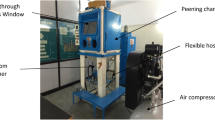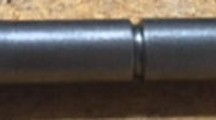Abstract
This paper investigates the effect of shot blasting and shot peening parameters on residual stresses induced in connecting rod. Compressive residual stresses are induced using shot peening to increase fatigue life of connecting rod. Shot peening is also responsible for increase in surface roughness. Surface roughness is detrimental for fatigue life of the connecting rod. This necessitates shot blasting to reduce surface roughness. Shot peening and shot blasting processes are analysed to find optimum process parameters which will induce required value of compressive residual stress on the surface of connecting rod. Compressive residual stresses induced in the connecting rod specimen have been experimentally measured using X-ray stress analyser. The experimental results have been analysed using grey relational analysis to find optimum values of process parameters for target value of compressive residual stress and surface roughness. The experimental investigation and the analysis of it have resulted in achieving the desired value of compressive residual stress, which is 10.5% higher over the existing connecting rod. Surface roughness also decreases to 3.84 Ra which is 8.5% lesser than specified value to achieve better fatigue life.




Similar content being viewed by others
Abbreviations
- x :
-
Magnitude of compressive residual stress
- y :
-
Surface roughness value
- i :
-
Experiment number
- R :
-
Grey relation value
- γ :
-
Grey relational coefficient
- η :
-
Grey relational grade
- w :
-
Constant depending on weightage assigned to process parameters
References
Yamagata H, The Science and Technology of Materials in Automotive Engines, Woodhead Publishing Limited, Cambridge (2005), p 208.
Clarke P, Green M, and Dolman R, in 4th International Conference on Steels in Cars and Trucks, Braunschweig, Germany (2014), p 444.
Fedoryszyn A, and Zyzak P, Arch Metall Mater55 (2010) 813.
Champaigne J, Shot Peening Overview, Metal Improvement Co, Chatsworth (2001), p 3.
Niku-Lari A, An Overview of Shot Peening Process, Advances in Surface Treatments, Vol. 5, Pergamon, Oxford (1987), p 155.
Kuo Y, Yang T, and Huang G-W, Comput Ind Eng55 (2008) 80.
Donzella G, Gerosa R, Petrogalli C, Rivolta B, Silva G, and Beretta M, Procedia Eng10 (2011) 3399.
Bhuvaraghan B, Srinivasan S M, and Maffeo B, Int J Struct Changes Solids Mech Appl2 (2010) 33.
Julong D, J Grey Syst1 (1989) 1.
Raykar S J, D’Addona D M, and Mane A M, Procedia CIRP33 (2015) 293.
Wu H-H, Qual Eng15 (2002) 209.
Author information
Authors and Affiliations
Corresponding author
Additional information
Publisher's Note
Springer Nature remains neutral with regard to jurisdictional claims in published maps and institutional affiliations.
Rights and permissions
About this article
Cite this article
Pathak, C., Dodkar, P. Effect of Shot Blasting and Shot Peening Parameters on Residual Stresses Induced in Connecting Rod. Trans Indian Inst Met 73, 571–576 (2020). https://doi.org/10.1007/s12666-020-01866-3
Received:
Accepted:
Published:
Issue Date:
DOI: https://doi.org/10.1007/s12666-020-01866-3




